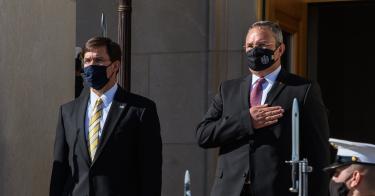Recently, Romanian National Defense Minister Nicolae Ciucă visited Washington, D.C. for talks at the Pentagon. The top item on the minister’s agenda: the stability of the North Atlantic Treaty Organization’s (NATO) southern flank, particularly the Black Sea. Romania’s near fixation on Black Sea security has become the itch begging for a transatlantic scratch.
This summer, Romania published a new security strategy that clearly focused on the importance of stability in the Black Sea region. The motivation seems pretty clear. Russia continues to build up its military capability in the region.
Putin has made this move with good reason. “The Black Sea, and specifically Russia’s illegal occupation of Crimea, serves as a springboard to project military power in places like Georgia, Ukraine and even as far away as Syria,” notes Heritage Foundation expert Luke Coffey. “The control of the Black Sea also means total control over the Sea of Azov (a small body of water surrounded by Russia and Ukraine connected to the Black Sea by the Kerch Strait).”
Putin remains a strategic opportunist, always searching for any weakness in his opponents and any opportunity to expand Moscow’s hard sphere of influence. The new Romanian strategy is not intended to confront or antagonize Russia. It seeks simply to disabuse Putin of any notion that there is a gap in NATO’s southern flank that Moscow might easily exploit.
There is little question that Romania’s national security strategy is focused on blocking Russian expansion. Clearly, Russia sees this. Right after the strategy came out, a spokesperson of the Russian Ministry of Foreign Affairs attacked the strategy.
But Romania’s concern extends beyond the Kremlin proper. It is also concerned that China could use its influence in Western Europe to undermine NATO cohesion and response to potential Russian aggression. That is implied in the strategy and explicit in a number of recent Romanian actions.
Last year, the United States and Romania, signed a 5G agreement to “seek to avoid the security risks that accompany Chinese investment in 5G telecommunications networks.” In January, Prime Minister Ludovic Orban announced the termination of cooperation with Beijing on the expansion of the nuclear power plant in Cernavodă.
Romania struggles to focus NATO’s attention on the Black Sea. The Black Sea is one of many issues where there is no consensus among the member states. Turkey, in particular, has been reluctant to support an expansion of NATO’s naval presence in the Black Sea.
Bucharest’s response has been to turn to the United States and press for more American engagement. Their approach has been to encourage the Americans to do more, by demonstrating that Romania is willing to do more. Romania was one of nine NATO allies last year to spend the required minimum of 2 percent of gross domestic product (GDP) on defense (2.04%), and one of sixteen member nations to spend 20 percent of their defense budgets on “major new capabilities” (25.7%).
Romania is buying U.S. equipment, too. In 2017, Bucharest signed a $3.9 billion contract to purchase seven Patriot missile defense systems. A year later, it announced would purchase three more, bring the total acquisition to ten systems acquired. The first shipment of Patriot missiles arrived in Romania last month. Romania has also purchased the U.S. HIMARS rocket launcher system.
Bucharest also obtained twelve F-16s from Portugal in 2013, with delivery completed in 2017. In January, Portugal and Romania announced five additional F-16s would be winging their way east, with delivery completed in 2021. And Romania is reportedly interested in acquiring an additional thirty-six F-16s from allies.
In turn, the United States has significantly upgraded its presence in the region. Mihail Kogalniceanu Air Base in Romania has become a major logistics and supply hub for U.S. equipment and personnel traveling to the Middle East region. The U.S. recently announced it also plans to reposition some air assets from Germany to Romania.
Romania also hosts an Aegis Ashore site in Deveselu, which became operational in May 2016.
In addition, the U.S. has also pushed for increased NATO presence. The alliance has agreed to develop a “tailored forward presence” in the southeast part of the alliance territory. The land component of this presence is a multinational framework brigade based in Craiova, Romania, under the control of Headquarters Multinational Division Southeast (HQ MND–SE) in Bucharest. The 5,000-strong brigade consists mainly of Romanian troops, supplemented by Bulgarian and Polish troops and headquarters staff from various other NATO states.
America and Romania jointly organize a biannual exercise named Saber Guardian, which is designed to improve the integration of multinational combat forces. In the 2019 iteration, almost 8,000 soldiers from six countries—Albania, Bosnia and Herzegovina, Bulgaria, Romania, Hungary and U.S.—participated in exercises in Bulgaria, Hungary, and Romania.
These efforts are laudable, although arguably not enough to establish the level of conventional deterrence necessary to dissuade Russia from engaging in malicious behavior. Still, Romania’s self-help model has effectively encouraged more U.S. engagement and shifted NATO’s strategic focus. It’s a model Romania can build on and one other NATO partners would do well to follow.
This piece originally appeared in the National Interest https://nationalinterest.org/blog/buzz/romania-leading-nato-build-black-sea-170999




